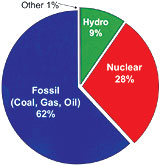Downwind from TVA

Where electricity comes from: A breakdown of the TVA’s power generation in 2005. The “other” category represents renewable energy.
|
“The story is, air quality is improving,” John Myers, an air-program manager at the Tennessee Valley Authority, announced before an audience gathered at the A-B Tech campus on Aug. 28. The presentation, sponsored by the Land-of-Sky Regional Council, was on TVA and regional air quality. “In fact, when we monitor air and we look for all the national-quality standards and we look at fine particles and ozone, we’ve probably not seen this good air quality in our lifetimes. But it needs to go further.”
Since 1977, TVA has invested more than $4.4 billion in pollution-control equipment, Myers says. In that time, they’ve reduced their sulfur-dioxide emissions by 80 percent, including a 47 percent reduction over the last 10 years. Six of their coal-fired plants — 30 percent of TVA’s capacity — currently have “scrubbers” that remove sulfur dioxide formed during coal combustion. By 2010, once four new scrubbers currently under construction have been installed, about half of their coal capacity will be scrubbed.
A new EPA regulatory program called the Clean Air Interstate Rule, designed to keep pollutants from migrating across state boundaries, will permanently cap emissions of sulfur dioxide and nitrogen oxides in 28 states in the eastern United States To comply with that new rule, which will be in full effect by 2015, TVA expects to spend an additional $3 billion to $3.5 billion. “We’ve said that this rule is stringent, and it’s expensive, but it’s doable. And we think it’s the right way to go,” Myers said.
The federally controlled TVA is the nation’s largest power company, providing power to nearly 8.5 million people. Sixty-two percent of its power generation is derived from fossil fuels, and just under a third comes from nuclear facilities. Many of its plants are some 40 years old.
In January of this year, a lawsuit was filed against TVA by N.C. Attorney General Roy Cooper charging that emissions from its 11 coal-fired plants migrate across state borders and into Western North Carolina, impacting public health, the environment and the economy of our region. Due to WNC’s topography and the natural airflow from west to east, this region bears the brunt of TVA pollution, the lawsuit charges. The trial is set for October of 2007.
TVA is also the country’s number-one buyer of coal, and its Kingston, Tenn., plant alone burns the equivalent of 140 railroad-cars (14,000 tons) of coal per day, according to the company’s Web site. Since coal incineration emits carbon-dioxide, a greenhouse gas linked with climate change, the question-and-answer session at the meeting prompted an obvious query: “What can be done to control carbon-dioxide emissions at TVA plants?”
In short, very little, as Myers indicated the TVA does not have the technology to control carbon emissions. “We are bringing on additional nuclear capacity,” he offered. “As nuclear comes on, that will lessen our carbon-dioxide emissions.”
TVA was mentioned in the news last week after the Nuclear Regulatory Commission found that tritium, a low-level radioactive material, had leaked into groundwater at three of its nuclear plants in Tennessee.
Stephen Smith, executive director of the Southern Alliance for Clean Energy, says his group began as a TVA-watchdog organization. “TVA deserves good credit for what they’ve done on nitrogen oxide reduction, but they deserve a D for what they’re doing on sulfur,” Smith maintained in an interview with Xpress. “The fact that they’re coming down is good, and while the charts with the downward slope seems impressive, the amount of sulfur that they used to emit was astronomical. And even after doing all that they’ve committed to, only 17 of the 59 boilers at their 11 coal-fired power plants will have pollution-control equipment for sulfur. The bottom line is that they’re still emitting hundreds of thousands of tons more than they should.”



Before you comment
The comments section is here to provide a platform for civil dialogue on the issues we face together as a local community. Xpress is committed to offering this platform for all voices, but when the tone of the discussion gets nasty or strays off topic, we believe many people choose not to participate. Xpress editors are determined to moderate comments to ensure a constructive interchange is maintained. All comments judged not to be in keeping with the spirit of civil discourse will be removed and repeat violators will be banned. See here for our terms of service. Thank you for being part of this effort to promote respectful discussion.